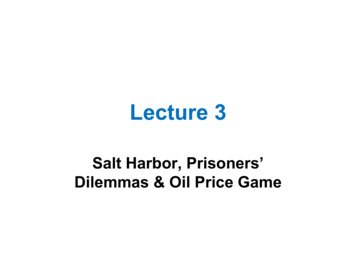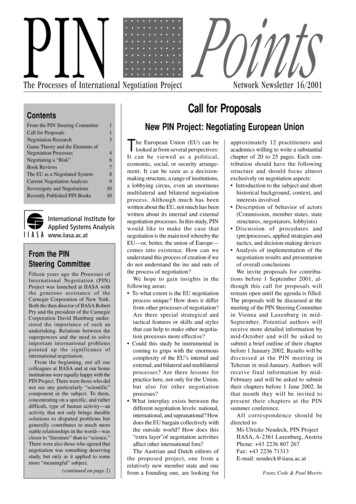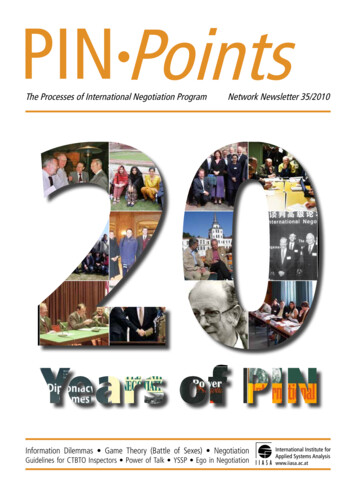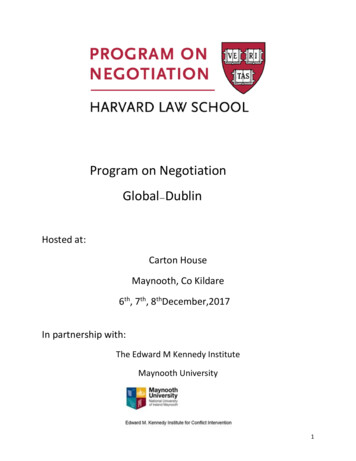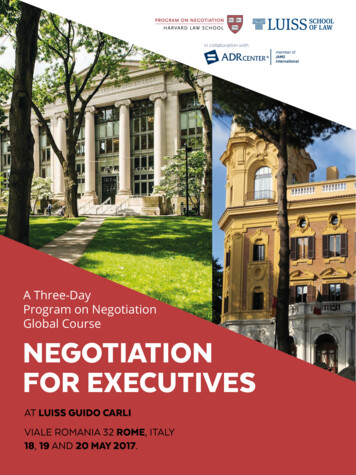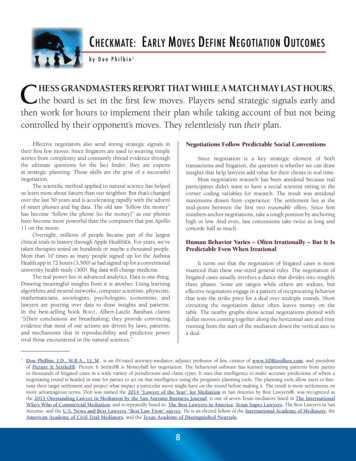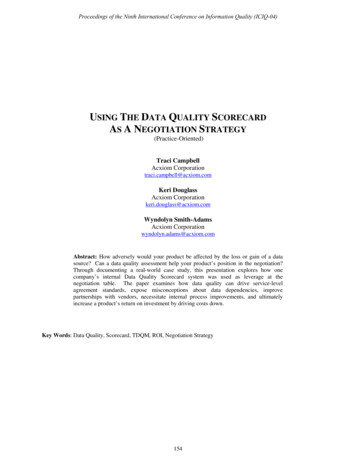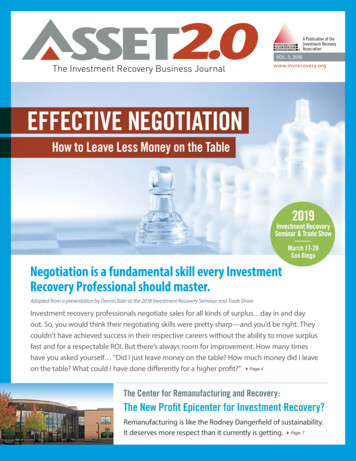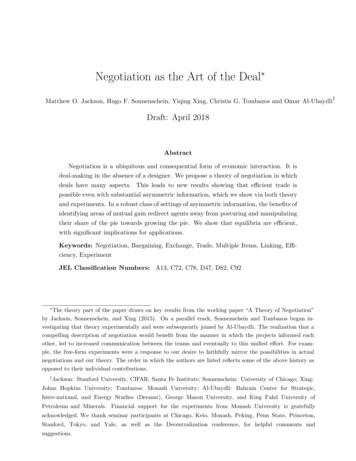
Transcription
Negotiation as the Art of the Deal Matthew O. Jackson, Hugo F. Sonnenschein, Yiqing Xing, Christis G. Tombazos and Omar Al-Ubaydli†Draft: April 2018AbstractNegotiation is a ubiquitous and consequential form of economic interaction. It isdeal-making in the absence of a designer. We propose a theory of negotiation in whichdeals have many aspects. This leads to new results showing that efficient trade ispossible even with substantial asymmetric information, which we show via both theoryand experiments. In a robust class of settings of asymmetric information, the benefits ofidentifying areas of mutual gain redirect agents away from posturing and manipulatingtheir share of the pie towards growing the pie. We show that equilibria are efficient,with significant implications for applications.Keywords: Negotiation, Bargaining, Exchange, Trade, Multiple Items, Linking, Efficiency, ExperimentJEL Classification Numbers: A13, C72, C78, D47, D82, C92 The theory part of the paper draws on key results from the working paper “A Theory of Negotiation”by Jackson, Sonnenschein, and Xing (2015). On a parallel track, Sonnenschein and Tombazos began investigating that theory experimentally and were subsequently joined by Al-Ubaydli. The realization that acompelling description of negotiation would benefit from the manner in which the projects informed eachother, led to increased communication between the teams and eventually to this unified effort. For example, the free-form experiments were a response to our desire to faithfully mirror the possibilities in actualnegotiations and our theory. The order in which the authors are listed reflects some of the above history asopposed to their individual contributions.†Jackson: Stanford University, CIFAR, Santa Fe Institute; Sonnenschein: University of Chicago; Xing:Johns Hopkins University; Tombazos: Monash University; Al-Ubaydli: Bahrain Center for Strategic,Inter-national, and Energy Studies (Derasat), George Mason University, and King Fahd University ofPetroleum and Minerals. Financial support for the experiments from Monash University is gratefullyacknowledged. We thank seminar participants at Chicago, Keio, Monash, Peking, Penn State, Princeton,Stanford, Tokyo, and Yale, as well as the Decentralization conference, for helpful comments andsuggestions.
1IntroductionNegotiation is a ubiquitous and economically important form of social interaction. Twoparties come together to reach an agreement: a “deal”. Such deals are generally complex.For instance, an agreement between a firm and a union would typically include: salaries,responsibilities, profit-sharing, work-hours, a pension, a medical plan, vacation-hours, safetyrules, seniority, promotion-schedules, etc.Despite the prevalence and complexity of such negotiation problems, the only models thateconomists have that offer insights into negotiations are models of ‘bargaining’: splitting apie. Bargaining models are fundamental to predicting how people split a known surplus(e.g., Nash 1953 and Rubinstein 1982), as well as to understanding why people may failto reach an efficient agreement when bargaining over a price at which to potentially tradesome object over which they have privately known values (e.g., Myerson and Satterthwaite1983). However, bargaining models do not offer much insight into the multiple dimensionalnegotiation problems that management consultants and practitioners spend much of theirtime on. For instance, Fisher and Uris celebrated 1983 book on negotiating, “Getting toYes,” which is extensively used by practitioners, is much more about how to find and craftthe right deals, than about how to agree on a price. It includes statements like: “Realizethat each side has multiple interests,” “Broaden the options on the table rather than look fora single answer,” and “Search for mutual gain.” These statements are not to be dismissed,but instead suggest that we need a theory that explains why these issues are central tonegotiations.Moreover, a gap between observed behaviors and what we might expect from bargainingmodels also calls out for a model of negotiations. In particular, extrapolating from the resultsof Myerson and Satterthwaite (1983), one would be tempted to predict that negotiations willbe inefficient. Curiously, however, there is relatively little empirical evidence in support ofsuch inefficiency. In fact, between 1948 and 2005 “idleness due to strikes in the United Statesnever exceeded one half of one percent of total working days in any year” (Kennan 2005).Since 1990 average lost time has been about twenty minutes per year per worker in the U.S.;and even in a more strike prone country, like Spain, the number is less than 1/3 of a day perworker per year (again, Kennan 2005).In this paper, we present a model of negotiation that includes substantial asymmetricinformation, and yet predicts efficient outcomes. Our model sheds light on this apparentparadox by showing how negotiating over multiple dimensions provides strong incentives forpeople to reach efficient outcomes. It makes clear why negotiations over multiple dimensionscan be efficient while bargaining over a single object for trade can lead to inefficiency. Indoing this, the theory offers insights behind the above quotes from ‘Getting to Yes’. We alsopresent experiments that illustrate the contrast between bargaining over one dimension and1
negotiating over several.There are three key aspects to our theory.The first is that negotiations involve multiple dimensions, rather than just one. There isa deal to be crafted rather than just one good to be traded.The second is that asymmetric information between the two negotiating parties is primarily about which deals maximize their gains from trade, rather than whether there existgains from trade. Without knowing that there are gains from trade, added dimensions wouldjust complicate the inefficiency. As dimensions expand, so do opportunities to find mutualgains from trade, and agents become increasingly sure that there are gains from trade, andhow large they must be.1 The incentives of the agents turn to finding those gains from trade,rather than posturing to take advantage of uncertainty.The third aspect of our theory regards how people negotiate. One might conjecture thatthe simple expansion of opportunities and known gains from trade make it obvious thatoutcomes will be efficient. An important preliminary result is that this intuition is wrong.We provide a simple example that strongly makes this point. There are just two goodsand it is common knowledge that both involve positive gains from trade and exactly whatthe total gains from trade are. The only uncertainty is about which good has the highergains from trade. This example illustrates very starkly the contrast between ‘bargaining’and ‘negotiating’. Here we show that if agents bargain over the goods, so that they offerand counter-offer prices for each of the two goods separately, then despite the commonknowledge of the gains from trade and that both goods provide positive gains, all equilibriaare inefficient. In contrast, if agents negotiate, so that they can propose deals involvingmultiple goods, then all equilibria are efficient. The distinction between negotiating andbargaining is very consequential.This previews our more general theoretical results. When agents understand the richnessof the set of deals that they can propose, then their incentives become aligned and instead ofconcealing information and posturing, it becomes in their interest to share information andfind the right deal. To understand why negotiation works, it is useful to distinguish betweentwo varieties of asymmetric information. The first is knowledge of the overall possible gainsfrom trade. The second is knowledge of the particular deals that realize these gains. Evenwith knowledge of the overall gains from trade, asymmetric information can mean thatneither agent alone knows which deals are efficient. They must negotiate to find those deals.An essential insight behind our main results is that the knowledge that there exist efficientdeals crowds out inefficient deals. Offering a deal that is inefficient is dominated by offeringa set of deals that includes all the ones that could be efficient - even if one is not sure which1Whether approximate gains from trade are known in labor-management negotiations is an empiricalquestion. In Section 4 we comment on a range of situations in which the gains from trade are known.2
one it is - as that leads to a higher total surplus to be split and the proposer can ask fora bit more than she was asking for with the inefficient deal in every one of the potentiallyefficient deals offered. Our general result applies to a broad class of negotiation problemsand ways in which agents communicate, but this intuition is at its heart.In addition to our theoretical results, we present a set of experiments that provide resultsthat illustrate this contrast between bargaining and negotiations. Not only do we findpredicted inefficiency in bargaining and efficiency in negotiations, but the ways in whichagents negotiate and find their mutual gains of trade line up remarkably well with ourtheory.Our paper proceeds as follows. In order to fix some main ideas, Section 2 presents anexample of a negotiation problem over multiple goods that, as described above, illustratesthe multi-dimensional negotiation setting and shows how it is the combination of knowledgeof gains of trade, and understanding of the ability to offer a rich set of deals that leadsto efficiency; and that knowledge of the surplus alone with simple dimension-by-dimensionbargaining leads to inefficiency. This sets up our experiments and theory.In Section 3 we present results from experiments involving 340 subjects. The basis for theexperiments is exactly the examples from Section 2. Some subjects were put into treatmentsin which they bargained over individual items, based on the examples; while other subjectswere put into treatments in which they negotiated over four objects and were able to offermulti-aspect deals. The experimental results are very much in line with our analysis of theexample. The bargaining on one item is inefficient, exhibiting delay, posturing, and failureto trade. The negotiations over four items together leads to highly efficient outcomes. Inparticular, in the bargaining treatments 67 percent of the surplus is obtained - with theinefficiency coming from both substantial delay and outright failure to trade when thereare positive gains from trade (only 87 percent of pairs with positive surplus managed toeventually trade).2 In contrast, in the negotiation treatments 86 percent of the surplus isreached, and the right trades are eventually made in 98 percent of the matches. Given oursubstantial sample size, both of these differences are significant. The results quoted aboveare for an alternating-offers version of the treatments. We also did free-form versions of thetreatments in which agents could chat and fill in details of offers until they reached mutualagreement. This variation increased the efficiency of both treatments: in the bargaining(one-item) treatments in free-form the efficiency is 75 percent (still only 87 percent of pairswith positive surplus managed to eventually trade), while in the free-form negotiation (fouritem) treatments 92 percent of the surplus was reached (with 99.6 percent of the righttrades eventually being made). The chat was cheap talk and did not affect the actual offers2This is in fact even worse than the a theoretical bound on the efficiency that can be reached (by thesecond-best optimal mechanism) in this example with bargaining on each individual item.3
available in the free-form treatments, and so the theory still tells us that bargaining shouldbe inefficient and negotiations should be efficient. Again, this is consistent with our theoryand analysis of the example, and the difference is significant.Thus, the experiments show a highly significant increase in efficiency with negotiation asopposed to bargaining with identical expected surplus and item-by-item uncertainty.In Section 4, we present our general theory of multi-aspect negotiation, giving efficiencyand uniqueness results. There is asymmetric information regarding how the agents viewalternative multi-dimensional deals, but the maximum surplus is known. We examine variousforms of alternating offer negotiations in which agents discount the future. We show thatwhen agents have rich enough ways of communicating so that they can offer menus of fulldeals or express their types and demand value, then all weak perfect Bayesian equilibriaare fully efficient and lead to a deal in the first period. In fact, the share of the surplusthat each agent receives is determined as in Rubinstein’s (1982) original full-informationbargaining theory. However, now the agents need to negotiate in order to discover the dealsthat generate maximum surplus. The offers made in a negotiation have a particular form.Directly or indirectly they present a set of alternative deals to a counter-party and give herthe opportunity to select one of them or decline. When the set of offers that agents selectfrom is “rich”, then the agents are able to offer a menu of deals that includes efficient dealsas possible outcomes. They are not required to do so; rather, it is in their self-interest. Theefficient ones dominate and drive out the inefficient ones, by being able to offer better termsto both agents. This is the invisible hand that enables efficiency.We include an explanation of a duality between two different ways of negotiating: one byoffering menus of deals to the partner to choose from; and the other by revealing preferenceinformation to the partner and then allowing them to craft a deal that delivers a requestedpayoff. Interestingly, we show evidence of both of these being used in the free-form negotiation treatments of the experiment.A companion
19.04.2018 · Negotiation as the Art of the Deal Matthew O. Jackson, Hugo F. Sonnenschein, Yiqing Xing, Christis G. Tombazos and Omar Al-Ubaydliy Draft: April 2018 Abstract Negotiation is a ubiquitous and consequential form of economic interaction. It is deal-making in the absence of a designer. We propose a theory of negotiation in which deals have many aspects. This leads to new results showing that e .



